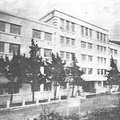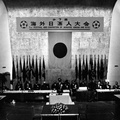The Japanese name "Sujiro"?!
One of the characters in Menimo Maluquinho (Boy Marquinho) by Ziraldo, a famous Brazilian manga artist, is a Japanese-Brazilian named Sugiro. Names like Ichiro and Sushiro might be understandable, but Sugiro is strange no matter how you look at it. I had felt for a long time that it was odd for a Japanese or Japanese person to have a name like that. Then one day, the mystery was solved all at once. It turns out that the name was born from a piada (a Brazilian joke). This story is interesting in that it gives us an idea of how Japanese-Brazilians are perceived in Brazil.
Sujiro is a boy who lives in the neighborhood of the main character, a young boy called Marquinho, and is of Japanese descent. Like most Japanese people, he is obedient, quiet, and studious. His biggest passion is computers. He is completely absorbed in the Internet, and his mother wants to get him out of his room. However, the website explains that the only person who can get Sujiro to go outside is Marquinho. The piada (joke) that gave rise to the name Sujiro, titled "A Brazilian Name," is as follows:
"Um nome brazilian"
Although a Japanese man lives in Brazil, that's where it is. How could this be a home in a place where we could call it colherence, we resolved to give a Brazilian name to the filthy.
A friend of mine suggested that I
- Sugiro Alberto, Ronaldo, Carlos, Antonio...
And I'm happy, I'm completely satisfied:
-My name is mine! My name is mine!
Nome garoto ser Sugiro, no?"A Brazilian Name"
As soon as the Japanese man arrived in Brazil, his wife was expecting a baby. He wanted to show respect to the country that had treated him so well, so he decided to give the baby a Brazilian name. So he asked a friend for some name suggestions, and received the following response:
- How about Alberto, Ronald, Carlos, Antonio...?
(*Sujiro means "I will make a suggestion" in Japanese.)
Upon hearing this, the Japon (a Japanese person) was extremely satisfied and said:
- What a great name. A great name.
The child's name is Sujiro.[This last line is a string of words and grammatical nonsense.] (Author's translation)
When translated into Japanese, the humor in the original language is lost, but the story is about how Japanese people who do not understand Portuguese well mistake the word Sugiro (a verb) for a name. There are several points to this, but the gist of it is that newly arrived Japanese people are teased because they do not understand Portuguese grammar or pronunciation well. This is why a word that would never have been used in the first place is adopted as a name, which is an ethnic joke. The name Sugiro is a symbol of this. In Brazil, there are many jokes like this against Portuguese people. It is a very funny story, and the person involved is not happy about it, but for Brazilians, this kind of teasing and play is one of the factors that show and deepen intimacy. Many Japanese people will hear this piada and laugh along with it, even if they smile wryly.
Registered Name
However, it is possible that there are Japanese people named Sujiro. I know two Japanese Brazilians of my acquaintances, Professor Okabayashi, a second-generation Japanese, and Professor Ishi, a third-generation Japanese. Professor Okabayashi's business card has his name written in the alphabet as Okabayaski. It seems that when his ancestors immigrated to Brazil, their names were mistakenly written that way when they were registered. Looking at the alphabet alone, one would assume that he was of Eastern European descent. In the case of Professor Ishi, I heard that his name was originally Ishii, but was registered as Ishi. It seems that there are quite a few such cases, not limited to Japanese immigrants.
It is difficult to correctly hear the sounds of foreign names, and it is extremely difficult to know how to write them after hearing them only once or twice. Even among Brazilians, there are probably very few people who can immediately write the name of the former Brazilian president, Kubitschek, as Kubitschek. My name, Shigeru, is written in the alphabet on my passport. However, when you pronounce it in Portuguese, you will be called Shigeru. To be pronounced Shigeru, you have to put SHIGUERU and U between GE. But even in that case, it will be pronounced Shigeru or mistaken for chiqueiro (pigpen). If it is registered as chiqueiro, it will be a laughing stock for the rest of my life, just like a Portuguese piada.
These phonetic similarities sometimes lead to jokes from Brazilians about Japanese names: if you have a bad tennis serve, you might be called "Sakamori-san" (saca mole, meaning weak serve), and because you're Japanese, you might like "fish" (sacana, meaning debauchery) or "chrysanthemums" (Que cu, meaning chrysanthemum, cu being vulgar).
Use of names
Depending on the time and situation, Japanese names can be a trigger for ridicule or discrimination. However, in South America, there is a second name (usually a baptismal name) or third name between the first name and last name, which acts as a buffer. For example, in the case of Wilson Shuji Onishi Hoshikawa, a Japanese Paraguayan, his last name is his mother's surname "Hoshikawa", his third name is his father's surname "Onishi", his first name is his local name "Wilson", and his second name is his Japanese name "Hidetsugu". In Brazil, the third name is often the mother's surname and the last name is the father's surname, and this pattern is common. However, this is only the full name registered, and in real life it seems that people often use two words, such as Wilson Hoshikawa. Japanese people often use Hidetsugu rather than Wilson at home or within Japanese communities. Of course, there are cases where only a Japanese name is given, or two or three names, but it depends on the case.
Expressing Japanese names in Japanese
There is a lot of variation in how the names of Japanese people are written in Japanese. Regardless of how the person writes it, in Japanese newspapers in North America, such as the Vancouver Shinpo and the North American Hochi, the names of Japanese people are written in the same way as in Japan if they are first-generation Japanese or have Japanese nationality, and in katakana if they are local Japanese, with the first name first followed by the last name. For example, Daniel Inouye and George Takei. However, in South America, for example, the Nikkei Shimbun and the São Paulo Shimbun, although there is no consistency, the names of second- and third-generation Japanese people are often written in the Japanese style, with the last name in kanji. For example, Takagi Raul and Otake Rui. Why is this? I suspect that it is because the writers are unconsciously aware that second- and third-generation Japanese people are also Japanese. Since there is no consistency, it is probably due to the reporter's personal consciousness rather than the newspaper's policy. In any case, there is no doubt that the writer's thoughts are reflected in the names.
Japanese names that are lost
Recently I "discovered" two people of Japanese descent. One is Marcy Costa, who works at the Brazilian Consulate General in Japan. When I talked to her, I found out she is of Japanese descent. When I received her business card, her name was written as Marcy Tagawa Oliveira Costa. Now that I think about it, I can certainly see traces of Japanese descent in her. In Marcy's case, Tagawa is her mother's, Oliveira is her father's, and Costa is her husband's surname. The other is Natasha Allegri, whom I found on the Internet. She is a comic book artist, and although she does not have a Japanese name, her mother has roots in Okinawa and is of Japanese descent. We are now in an era where Japanese surnames and given names are disappearing from the names of Japanese descent, and it is no longer possible to determine whether someone is of Japanese descent by their name, let alone their appearance. It feels sad that their names are being forgotten, but at the same time, I strongly feel that Japanese descent has entered a new era.

© 2018 Kojima Shigeru






